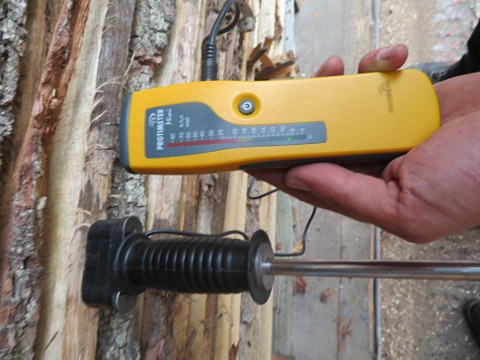Quality Timber takes Time: The Journey from Log to Timber
- Scottish Wood
- 6 days ago
- 4 min read
At first glance, the stacks of logs sitting at our sawmill might appear like just a pile of raw material waiting for a machine to transform it into beautiful timber. However, behind every piece of quality wood, there’s a carefully crafted process that involves our time, attention, and patience. The journey from log to timber is not instantaneous - it’s a series of carefully planned steps that ensures the wood not only looks great but also functions as intended in every project.
Here’s a dive into the process of how Scottish Wood Sawmill creates the Quality wood we supply you, for use in your furniture, floors, building, craft or diy projects.
Step 1: Selecting the Right Logs
The journey begins before our Sawmill even starts running its machines. Choosing the right logs is the first and most crucial step in the process. Not all logs are created equal. The type of tree, how and where the tree was grown, how the tree was harvested, and the quality of the wood, all play a role in determining the final product.
Wood selection can depend on various factors like log health, grain pattern and structural integrity. With our experienced eye (over 25 years experience!), we can select healthy trees, free from disease and defects, to produce higher-quality timber. Logs are carefully examined for imperfections like knots, cracks, or twisting, which can affect how the wood will perform once it's milled. All of our logs are sourced sustainably in Scotland.
Step 2: Storing the Logs
Once the logs are selected, they need to be stored properly. Logs are typically stacked in our log yard where they are piled up in a way that allows for airflow. This air circulation is critical, as it helps prevent mould, mildew, and insects from damaging the wood before it’s milled.
Logs are often stored for a certain period of time to allow for acclimatisation, which means the logs adjust to the surrounding environment before they are cut. If the logs are milled while they’re still too wet or too dry, it can affect the quality of the timber produced.
Step 3: Milling at the Right Season
The season in which logs are milled can have a significant impact on the quality of the wood. Our Sawmill generally prefers to mill logs in the winter or early spring, when the tree's sap has receded, and the wood is less likely to be full of moisture. Milling during this time ensures that the wood has better stability and is less prone to warping or shrinking after it’s dried.
Milling at the right time also means our Sawmill can get the most out of each log. The process of cutting the logs into beams/boards is done strategically to maximise yield while minimising waste. At Scottish Wood Sawmill, we use sophisticated Woodmizer equipment to make precise cuts and achieve the best possible result from each log.
Step 4: Air Drying the Timber
Once the logs are milled into boards, they must be dried. Freshly cut timber, also known as "green" timber, contains a high amount of moisture. To ensure the wood’s strength, stability, and finish quality, it needs to lose some of this moisture through drying.
Air drying is a natural, traditional method of drying timber - where the boards are stacked with spacers (called stickers) between each layer to allow air to flow freely. This process can take years, depending on the thickness of the wood and the weather conditions – our general rule is 1 year per inch of timber thickness.. The beauty of air drying is that it allows the wood to dry slowly, which reduces the chances of warping or cracking, resulting in more stable, higher-quality timber.
Step 5: Kiln Drying the Timber
While air drying is effective to a point (Scottish weather can be unpredictable!), our Sawmill has 3 kilns onsite for kiln-drying process which results in more control over the moisture content and to speed up the drying time and to produce quality timber suitable for interiors and furniture making. Kiln drying uses a controlled environment with heat, humidity, and airflow to accelerate the final drying process.
Kiln drying is especially helpful for certain types of wood, like our hardwoods intended for fine furniture, where precise moisture content is important to avoid issues like shrinking or warping. The controlled temperature and humidity in our kilns ensure that the wood dries evenly and at the right rate. Our kilns are heated using waste products from our milling, ensuring a closed-loop system that minimises waste and maximises efficiency. Instead of discarding sawdust, wood chips, and other byproducts, we repurpose them as a renewable energy source. This process lowers emissions, and supports a self-sustaining production cycle.
Step 6: Final Milling and Grading
Once the wood has been properly dried, (depending on its intended purpose) it undergoes a final milling process where it is smoothed (planed flat) and sized to meet specific standards. It’s also visually graded based on its appearance and quality, which helps determine its value in our Timber-shop where our planed boards are available for purchase. Rough sawn stock goes directly from our kiln to our stores for customer selection.
At this point, the wood is now ready to be used in a variety of projects, from custom crafts, diy to interior design/renovation, cabinetry and furniture making. It’s important to note that the wood’s final quality is largely influenced by the earlier steps in the process. Without careful selection, proper storage, and precise drying techniques, the final product would likely be prone to warping, cracking, or other defects.
Conclusion: Patience and Expertise Matter
The process of turning a log into a high-quality useable, piece of timber takes time, expertise, and careful attention to detail. From selecting the best logs and storing them properly to drying and milling at the right times, every step is crucial for ensuring that the final product is durable, stable, and beautiful.
Whether you’re building or crafting a custom piece of furniture, understanding the care and attention that goes into creating quality wood will help you appreciate the true value of every piece of timber that ends up in your project.
Our stunning Native hardwoods are definitely worth the wait!
Visit onsite to browse our extensive range of stock 1st hand! We are open to all Monday to Thursday 8am to 4pm and the 1st Saturday of the month 9am to 2pm.













































Comentários